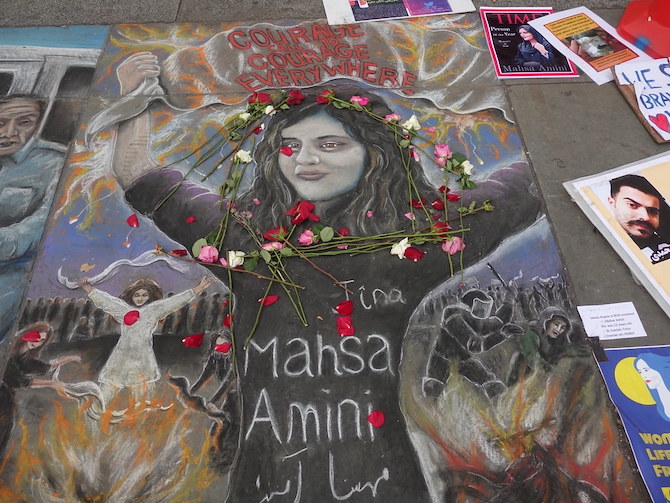by Bako Kheladze

The death in police custody of the young Iranian woman Mahsa Amini, arrested for “incorrectly” wearing the hijab, has triggered a large-scale unrest across Iran. Along with large cities such as Tehran, Esfahan, Shiraz, and Bushehr, smaller towns and settlements joined the anti-governmental protest. Especially active are Kurdish-settled provinces as Mahsa Amini was ethnic Kurd. Despite the initial anti-hijab and women’s rights characteristics of the protests, they gradually evolved into an anti-regime movement and encompassed different people regardless of their gender, social, or political identities.
Mainstream media portrays the ongoing protest as unprecedentedly large in the history of the Islamic Republic of Iran and some of them even go further to announce it as a feminist revolution. In reality, the scale of the protest is high but it cannot be said to be bigger or bloodier than the 2019 October protest (“Bloody Aban Protest”) as we do not yet have precise figures. Nevertheless, what differentiates the current protest from the past ones is the self-organisational level of the people. It seems that Iranians have learned how to fight back the security forces and how to organise a protest via virtual spaces when the government imposes restrictions on the internet. It is worth noting that, after so many clashes and raids, Iranian protesters have not lost their self-confidence but rather gained it. Thus, regardless the outcome of this protest, people feel empowered and, in the future, will take a more radical position against the government.
Practically, since the 2019 October revolt, no large-scale protest has taken place in Iran. There have been regular teachers’ protests, local riots in Ahvaz and small protests in Esfahan. However, the current protest is the first one since 2019 which covered the whole country. After the bloody raids in 2019, many Iranians sank into pessimism and thought that they could not stand up against the government anymore. Nevertheless, heavy social-economic issues, the appointment of an unpopular president with a discredited cabinet of ministers, and the hardening of Islamic moral principles have created an unbearable situation for the citizens.
As for the anti-hijab movement, it started before Mahsa Amini’s death, in response to the exaggerating actions of the morality police, encouraged by conservative President Ebrahim Raisi. In the summer of 2022, the first anti-hijab movement was organised in social networks with the hashtag: نه_به_حجاب_اجباری (no to the compulsory hijab). Before this tragic event, anti-hijab activism had never gone beyond uploading a few images without a headscarf across different parts of Iran. The death of Mahsa Amini fuelled a long-accumulated aggression among Iranians and compelled riots.
Notably, the protest brought together anti-Islamic and some traditional Muslim Iranians against the government. Among the opposition are many who still believe in Shia Islam values but are extremely dissatisfied with the total collapse of the Velayate Faqih policies. The Islamic government has always had some loyal part of the society. The majority of them played a special role either in revolution or in different military conflicts such as Iraq, Syria and Lebanon. They enjoyed generous financial benefits from various Islamic foundations but the recent sanctions and hyperinflation had a negative impact on their quality of life. In addition, a large number of military and police officers have found themselves suffering from the same socio-economic problems as millions of Iranians. If we look at the dynamics of the protests over the last five years, these people have had to perform more difficult missions, while their salaries barely make ends meet. Thus, before going on a raid, many questioned themselves whether the system that cannot pay deserving wages is worth protecting or not.
There are two probable scenarios:
- The government successfully mobilises its military, police, and security forces and suppresses the protesters. However, this won’t guarantee that large anti-governmental protest waves will be avoided in the future.
- Protesters gain victory, which raises some questions: who will take political responsibility in the aftermath of the revolution? What can be an alternative to Shia Islam, which today brings different ethnical minorities around one flag?
To conclude, the level of anger in Iranian society is at its peak. The government is facing economic difficulties and losing its followers. If we take into consideration the speeches of the Supreme Leader and other high-ranking officials, they have nothing to offer to the people. No reconciliation is foreseen with the rebelled part of the Iranian society, meanwhile, the number of protesters is rising. Whilst change is on the horizon, a question remains – how will this process evolve? Will it go through the revolutionary path or will it finally lead the Velayate Feqih leadership to compromise on some principles and listen to the disgruntled?






